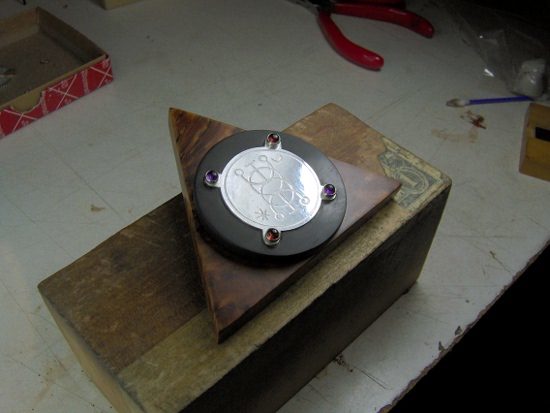Dies Mercurius
Luna wx 9%v
While coordinating the stage manager’s scene breakdown and notes with the costume designer’s costume plot in order to generate a working draft of the costume change tracks for the current show, I am struck by how many separate worlds-in-formation are headed on a direct collision course with each other this week, during tech.
Each department has created a fleshed out whole based on the (same, we hope) script and on various communications between them. But like the telephone game, there always end up being parts that were envisioned quite differently from one end of the common communication line to the other, the drafts being made/rehearsed.
We all, based on our varying degrees of intimacy with the script and the work being done with it to make it an actuality in the “real world” (practice, rehearsal & notes, drafting, plotting, etc.), are busy making mental models of what we imagine will happen when it makes it to the stage. We share a common story and as there is not time for every person in every department to check in with everyone else about every detail of what they are making (my gods, can you imagine? the endless meetings and discussions? scary) we do our thing simply trusting that what we do will fit with what everyone else is doing to make a viable piece of performed art.
We selectively communicate what we have prioritized as the most important things for the other department(s) to know about what we are doing and run with the rest. We trust that the others know their business and are good at executing it in the right way, at the right time, and in the right place. We trust them to make good decisions about their parts and communicate in the overlaps as well. That’s a hell of a lot of discrimination and trust.
The edges of the individual visions of the show that don’t match up perfectly are modified, reshaped, ground down, moved, tweaked, or otherwise coaxed into fitting and supporting the whole of the show when the time comes for all of us to bring our worlds to the same place and play them out at the same time. This is technical rehearsal, whose captains are the director and the various designers. All these emerging, colliding worlds (along with the long days/nights in the artificial environment of the theater space) cause a distinct warping of the perception of the passage of time and the reality we left outside. It is magical space. In terms of production-time, it is the secret behind the curtains as much as the literal “behind the scenes” actions are during the course of a show being performed. Rough, bumpy, intensive, frustrating, miracle-producing space.
It is willed mutual annihilation of the particular and multiple individual visions in order to bring about a unified living narrative that will in turn spawn another multitude of uniquely nuanced visions and narratives in the minds and bodies of the audience. With some luck, a few of those audience members will be inspired by the experience to make more art, or perform some other right-action in the world outside the theater-cave. Script to design to tech to performance to audience. One to many back to one back to the many who are composed of ones after all. The creative force undulates through it all.
.
Taking it back to the formative stage, from the maker’s perspective:
When one is practicing, a curious disregard of the actual in favor if the imagined ideal/desired end comes into effect. We reach for what we think is possible, and keep repeating our actions in the material until all deviations from the shape of the (imagined) goal in the piece are eliminated. What actually exists at any point in the process is secondary to the conception until the material piece embodies the conception as perfectly as we are able to make it do. Note: this has nothing to do with meaning, and all to do with form and being. Meaning is solely the business of the individual experiencing the art, and outside of what I’m talking about here.
It is not as mechanical and straightforward as it sounds, since in this place there is always more than one player in the game of creation. The environment and material has (and if a collaborative form, the other creators have) a say in what it will and will not be. Paying attention to the formation of the piece during the making will nearly always mutate the inspiration in beneficial ways. It ferments, and no one can say where the improving element comes from until it arrives. Stubbornly holding fast to the original mental picture while ignoring the process, “forcing” the piece is a recipe for a poor fit of inspiration and materiality, dullness, or disaster which amount to about the same thing. It’s laziness that totally wears you out.
In performance (in viewing, in interacting), the materiality of the thing regains dominance. It impacts, it inspires through the senses- visual, tactile, audial, etc. through the skin, the eye, the gut, through our physical equipment. There is no other way! At least the kind of art I prefer does. If you need to read an essay to “get it”, then it’s not doing its job. Or you aren’t. If it’s finished. If it’s truly an embodiment of something vital, if it has a “self” of its own. And as I said earlier, with some luck it will entice a few viewers to make aesthetic whoopie with it and go on to engender more art. Material back to imaginative again, and so on.
